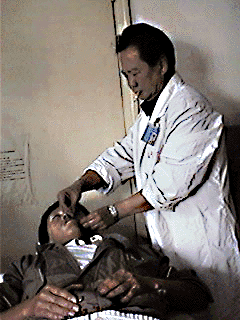Acupuncture Treatment of Bell’s Palsy

Bell’s Palsy is called “Zhong Feng” in China. This translates to “Wind Attack.” The following protocol represents the notes taken while working with Dr. Wang at the Yunnan Province Hospital of TCM in Kunming China.
Traditionally, Bell’s Palsy is, in TCM terms, wind-cold-damp in the facial channels. There’s a lot of Bell’s palsy in Kunming. Nobody knows why, and to my knowledge, no research has even been proposed to determine why. Be that as it may, the one good thing about all the Bell’s Palsy in Kunming is that they have been forced to develop some very effective treatment strategies in order to treat this local phenomenon.
With little exception, every patient recieves the following body points:
| Liver 3 | To move Qi |
| Kidney 3 | To tonify Qi |
| Spleen 6 | To tonify Qi |
| Stomach 36 | To tonify Qi |
| Gall Bladder 34 | To move Qi and eliminate wind |
| Large Intestine 4 | To eliminate wind from facial channels |
| San Jiao 5 | To move Qi and eliminate wind |
The following points are local to the pathology of wind-damp-cold in the facial channels:
| UB 1 | Inserted perpendicularly |
| UB 2 | Inserted obliquely, needle pointing lateral toward eyebrow |
| GB 1 | Inserted perpendicularly |
| GB 2 | Inserted perpendicularly |
| GB 14 | Inserted horizontally, needle pointing down toward eye |
| Stomach 2 | Inserted horizontally, needling pointing down toward chin |
| Stomach 4 | Inserted perpendicularly |
| Stomach 5 | Inserted horizantally, needle pointing in toward ear following channel pathway |
| Large Intestine 19 | Inserted perpendicularly |
| Large Intestine 20 | Inserted perpendicularly |
| SI 18 | Inserted perpendicularly |
| Bi Tong | Inserted perpendicularly |
The following points have both functional and local purposes:
| Ren 22 | Links the body’s Yin and Yang |
| Du 26 | Links the body’s Yin and Yang |
| San Jiao 17 | Stimulates ends of the seventh cranial nerve, the motor nerve that controls facial muscles. |
The needles are left in while the patient rests for 25 minutes.
The side of the face that is used varies from patient to patient. The more acute the condition, the more likely that some of the points will be bilateral, or even ipsilateral.
The logic here is that within hours of the first attack, during the initial acute phase, the opposite of the face is used for needling. During the chronic stage, only the effected side of the face is used. For patients who haven’t had the condition too long, some of the points are bilateral. As to how long is “not very long” it is difficult to say, since that decision seems to be based on parameters known only to Dr. Wang. Welcome to Chinese Medicine.
After the patient’s needles have been removed, cupping is used on Du 14 or GB 20 to remove wind and activate blood locally.
For some of the severe cases, local injections of vitamin B-12 is used or Dang Gui solution are used. These injections take place at the following sites: Large Intestine 11, San Jiao 17, Gall Bladder 20.

Wang Dai Fu with his trade mark oral moxa treatment.
This protocol is used five times per week. These are serious cases that we’re seeing, and the treatments are within the price range of most of those effected by this Bell’s Palsy.
The young man pictured receiving a treatment came in to the clinic unable to shut his right eye due to the Bell’s Palsy. He’d been treated by a doctor in the outskirts of Kunming for the past three months, however there had been no improvement in his condition.
After just two weeks, dramatic improvements had already been seen. He could now close his eye fifty percent before his daily treatment and one hundred percent during. Everyday he was looking better…
 Last modified: August 14, 2009
Last modified: August 14, 2009  Tags: Acupuncture, Bells Palsy · Posted in: Acupuncture
Tags: Acupuncture, Bells Palsy · Posted in: Acupuncture
